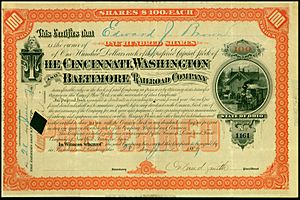Orland Smith facts for kids
Quick facts for kids
Orland Smith
|
|
|---|---|
| Born | May 2, 1825 Lewiston, Maine |
| Died | October 3, 1903 (aged 78) Chicago, Illinois |
| Place of burial |
Green Lawn Cemetery, Columbus, Ohio
|
| Allegiance | United States of America Union |
| Service/ |
United States Army Union Army |
| Years of service | 1861–1865 |
| Rank | |
| Unit | Army of the Potomac Army of the Cumberland |
| Commands held | 73rd Ohio Infantry Smith's Brigade, XI Corps |
| Battles/wars | American Civil War |
| Other work | railroad executive |
Orland Smith (born May 2, 1825 – died October 3, 1903) was an important leader in the railroad business. He also served as a commander in the Union Army during the American Civil War. In 1864, he led a brave attack with bayonets. This happened during the Battle of Wauhatchie. His charge helped capture a key position on a hill. Today, that hill is named after him.
Contents
Early Life and Railroad Career
Orland Smith was born in Lewiston, Maine, which is in New England. He went to school in his hometown. After finishing school, he started working for railroads. He became a station manager in Lewiston. In 1852, he moved to Ohio.
In Ohio, Smith became an official for the Marietta and Cincinnati Railroad. He lived in Chillicothe, Ohio. When the railroad faced money problems, he was put in charge to fix them. Before the Civil War, in the late 1850s, he was also a lieutenant and leader of a local soldier group called the "Chillicothe Greys."
Service in the Civil War
When the American Civil War began, Orland Smith joined the Union Army. He became a colonel of the 73rd Ohio Infantry regiment. A regiment is a military unit made up of many soldiers. This regiment was formed in Chillicothe in November 1861. They trained at a nearby place called Camp Logan.
One of the soldiers in his regiment was Private George Nixon III. He was the great-grandfather of future President Richard Nixon. Colonel Smith and his regiment fought in battles in western Virginia. These included the Battle of McDowell and the Battle of Cross Keys. Later that summer, his regiment fought in the Second Battle of Bull Run. This battle took place near Manassas, Virginia.
Leading a Brigade
On October 25, 1862, Smith took command of a larger group of soldiers called a brigade. This brigade was part of the XI Corps. He did not fight in the Battle of Chancellorsville. But he returned to lead his brigade just before the Gettysburg Campaign in 1863.
During the first day of the Battle of Gettysburg, Smith's men held a very important place called Cemetery Hill. They were ordered to do this by Major General Oliver Otis Howard. Smith's soldiers helped protect the Union troops who were falling back. On the second day of the battle, three of Smith's regiments fought hard near Cemetery Hill. The 33rd Massachusetts regiment helped stop an attack by Confederate soldiers from North Carolina.
Fighting in the Western Theater
In the fall of 1863, Smith's Brigade moved to the Western Theater. This was a different area of fighting in the war. During the Chattanooga Campaign, Smith led his brigade in the Army of the Cumberland. They made a very successful attack with bayonets up a steep hill. This happened during the Battle of Wauhatchie. The hill is now called Smith's Hill because of his bravery.
Later that year, his brigade was broken up. On January 3, 1864, Smith went back to leading the 73rd Ohio Infantry. He left his position as colonel on February 17, 1864. At the end of the Civil War, Orland Smith was given an honorary rank. He was made a brevet brigadier general. This rank was given to him on March 13, 1865.
After the War: Railroad Executive
After the Civil War ended, Orland Smith went back to working in the railroad business. He became the President of the Cincinnati, Washington and Baltimore Railroad. Later, he became the First Vice President of the Baltimore and Ohio Railroad. His office was in Baltimore, Maryland. From 1884 to 1899, he was also the President of the Columbus and Cincinnati Midland Railroad.
Orland Smith passed away in Chicago, Illinois. He is buried in Green Lawn Cemetery in Columbus, Ohio.



